
* During the Cold War, the Lockheed C-130 transport became a standard cargolifter for NATO nations. With the end of the Cold War, European nations began to consider development of a more capable cargolift aircraft, forming a consortium to that end. Progress wasn't rapid, but the Airbus "A400M" finally performed its first flight in 2009, with the type now in full service with a number of nations. Following the turn of the century, the Embraer company of Brazil began work on a follow-on to the C-130, with the "C-390" performing its first flight in 2015; it is now in widespread service. This document provides a history and description of the A400M and the C-390. A list of illustrations credits is provided at the end.
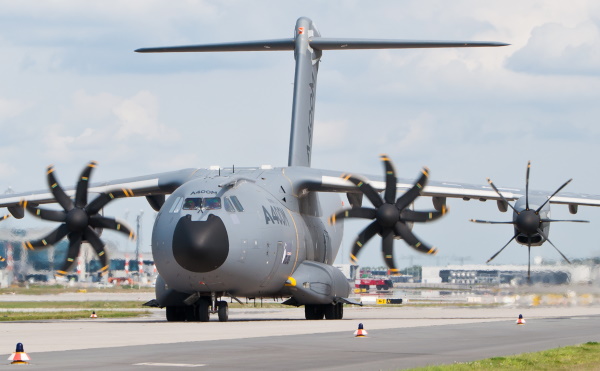
* In the early 1980s, a group of aerospace companies -- including Aerospatiale of France, British Aerospace (BAE) of the UK, Lockheed of the USA, and Messerschmitt-Boelkow-Blohm (MBB) of West Germany -- began consideration of the "Future International Military Airlifter (FIMA)", a tactical transport aircraft to replace the Lockheed C-130 Hercules and the Franco-German Transall C-160. Lockheed dropped out of the FIMA Group in 1989 to pursue development of the advanced C-130J Super Hercules, while Alenia of Italy and CASA of Spain joined up with the European group, which became "Euroflag".
From the outset, the program was politically complex, involving a bewildering set of nations and industrial partners. By 1992, the "Future Large Aircraft (FLA)" program, as it had been dubbed, had acquired backing from Belgium, France, Germany, Italy, Portugal, Spain, and Turkey, with the UK signing up later; by 1995, Euroflag had become linked with the European Airbus Industries group. Early concepts for the aircraft had envisioned turbofan propulsion, but as development progressed, turboprops became the preferred powerplant. At that time, initial service deliveries were slated for 2003, with initial production orders expected to total 300; the ultimate build was expected to be on the order of twice that.
However, it wasn't until 2003 that the partner nations committed to buy a total of 212 "A400M Atlas" cargolifters, the aircraft to be built by the European Aerospace & Defense Systems (EADS) Airbus firm, at the EADS plant in Seville, Spain. The program was to be under the general direction of the European Organization for Joint Armament Cooperation (OCCAR). That wasn't the end of the complications, Italy deciding to drop out, production totals being reduced to 180 machines, with initial flight in 2008 and first deliveries in 2009. Construction of the first prototype had begun in early 2007.
As it turned out, first flight of a prototype, designated MSN1, from Seville, was not until 11 December 2009; the prototypes were given the nickname of "Grizzly", the first machine of course being "Grizzly 1". By that time, the program was in considerable difficulty, with initial deliveries not slated until 2012, plus technical difficulties and cost overruns. South Africa, which had placed orders for the A400M, canceled them at that time. The RAF, as mentioned above, obtained C-17s to handle the gap in airlift capability to delivery of the A400M, while Lockheed Martin promoted the C-130J to A400M member nations.
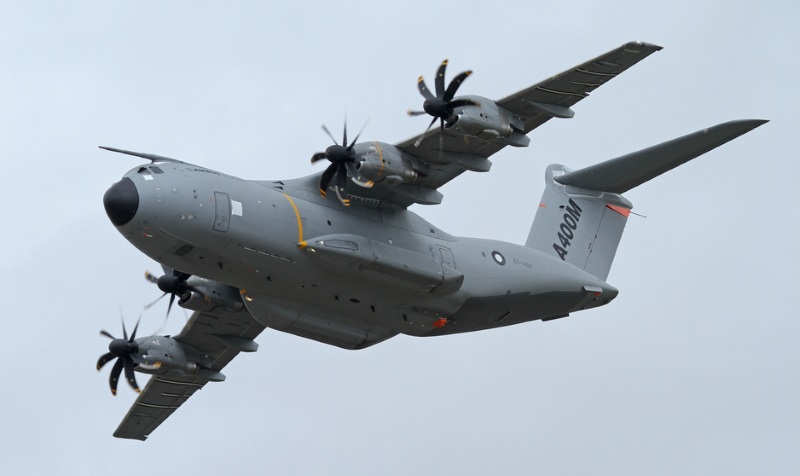
The program survived, thanks to an infusion of billions of euros after negotiations. The second A400M prototype, MSN2, performed its initial flight on 8 April 2010. Four more flight prototypes followed, with serial production of the A400M finally beginning in early 2011. Certification by the European Aviation Safety Agency was on 14 March 2013. Initial delivery of the first production aircraft, MSN7, to the French Armee de l'Air, was in August 2013, with a second following before the end of the year. At last count, there were 165 deliveries and firm orders for the A400M, including:
Deliveries of these aircraft are expected to be completed by 2025. Of course, other orders are likely to materialize. However, the program suffered a setback on 9 May 2015, when an A400M, the third to be delivered to Turkey, crashed in Seville during a pre-delivery flight test, four of the six crew being killed, the other two being badly injured. Some delays were to be expected in such a big program. A number of A400Ms served with distinction in the evacuation of Kabul in 2021. Two Turkish A400Ms were flying humanitarian supplies into Ukraine at the time of the Russian invasion in February 2022, to be stuck there for ten months because of the lack of a safe air corridor.
BACK_TO_TOP* As it emerged, the A400M had a typical cargolifter configuration, featuring a voluminous fuselage for cargo hauling, a rear loading ramp, main gear in sponsons alongside the fuselage, a high wing, and a tee tail. It featured considerable use of carbon-composite assemblies. All flight surfaces were swept. Its capabilities were between those of the C-130 and the C-17 -- with more cargo capacity and range than the C-130, but not as fast as the C-17.
The A400M was powered by four TP400-D6 turboprops, produced by EuroProp International (EPI) -- a consortium of Rolls-Royce of the UK, ITP of Spain, MTU of Germany, and Snecma of France. Each engine had an output of more than 8,205 kW (11,000 SHP), making the TP400-D6 the most powerful production turboprop ever made in the West. The engines featured full-authority digital engine controls (FADEC), and drove eight-bladed composite scimitar propellers with a diameter of 5.33 meters (17 feet 6 inches). The two props on each wing rotated in opposite directions to cancel torque; the engines were not "handed", which would complicate maintenance and logistics, the direction of rotation instead being determined by a gearbox switch. The props were variable and fully reversible, capable of backing a fully-loaded A400M up a 2% slope.
Two auxiliary fuel tanks could be installed in the cargo bay, increasing the total fuel capacity by 24%. The A400M had a removeable inflight refueling probe, mounted above the cockpit on the left; it could also be kitted up with a socket for boom refueling. In the tactical tanker role, the A400M could be fitted with a hose-drogue unit (HDU) pod on a pylon under each wing and a pallet-mounted HDU in the rear cargo bay, for three refueling points in all. The centerline HDU had greater fuel flow rate. The tanker kit was provided by Flight Refueling LTD of the UK. The underwing pylons could also carry electronic warfare (EW) pods.
The A400M had tricycle landing gear, the nose gear having two wheels, each main gear having 6 wheels in triple independent two-wheel assemblies, retracting into a sponson alongside the fuselage. The landing gear could "kneel" to facilitate cargo loading. The cargo bay was 17.71 meters (58 feet 1 inch) long excluding ramp, 4 meters (13 feet 1 inch) wide, and 3.85 meters high (12 feet 8 inches) -- 4 meters high aft of the wing. The cargo bay could be fitted for cargo, vehicle transport, troop transport, or medical evacuation. It could carry up to 20 one-tonne (2,200 pound) containers or pallets; nine standard pallets plus 58 troops, sitting in fold-down chairs along the walls of the fuselage; 120 fully equipped troops; 116 paratroops; or 66 stretchers with 25 medical personnel.
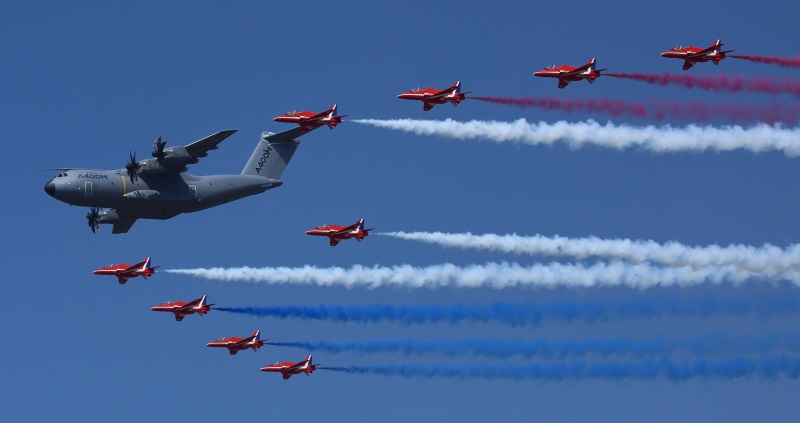
The rear cargo door could be opened in flight for airdrops. A powered moving crane with a maximum load of five tonnes (5.5 tons) was fitted to the ceiling of the cargo bay for moving cargoes. Cargo loading and airdrop could be supervised by a single loadmaster, using an onboard control system workstation, linked into a mission planning system. The system also controlled flight functions, including fuel management, communications, and ground collision avoidance.
___________________________________________________________________
AIRBUS A400M:
___________________________________________________________________
wingspan:
42.4 meters (139 feet 1 inch)
wing area:
221.5 sq_meters (2,383 sq_feet)
length:
45.1 meters (148 feet)
height:
14.7 meters (48 feet 3 inches)
empty weight:
76,500 kilograms (168,700 pounds)
MTO weight:
141,000 kilograms (311,000 pounds)
cruise speed:
555 kph (345 mph / 300 kt)
max speed:
780 kph (485 mph / 420 kt)
take-off length:
980 meters (3,210 feet)
landing length:
770 meters (2,525 feet)
service ceiling:
11,300 meters (37,000 feet)
normal range:
3,300 KM (2,050 MI / 1,780 NMI)
ferry range:
8,700 KM (5,400 MI / 4,700 NMI)
___________________________________________________________________
The A400M's avionics system leveraged off that developed for the Airbus A380 super-jumbo jetliner, including a fly-by-wire flight control system and a "glass cockpit", with nine color flat-panel displays and digital head-up displays. The A400M's cockpit was compatible with night vision devices. The aircraft was flown by a pilot and copilot, using sidestick controllers instead of the traditional yoke control, with a cockpit station for an optional mission equipment operator.
Other elements of the avionics system included militarized radios, including satcom transceivers; radio navigation and landing aids; a long-range navigation system including a GPS receiver and inertial navigation unit; and Northrop Grumman AN/APN-241E navigation-weather radar. German A400Ms were fitted with a low-level terrain-following system, clearly for support of special operations.
The A400M featured an automated defensive countermeasures suite, including radar and missile-launch warning systems, along with chaff-flare dispensers; a directed laser countermeasures system has been developed and will replace the chaff-flare dispensers in time. The A400M could also be fitted with crew armor protection and bulletproof windscreens, infrared shields for the engines, plus inert-gas fire retardation in the fuel system.
The tanker kit wasn't qualified at the outset. Airbus has demonstrated use of the A400M as an airborne drone launch platform -- hinting at the possibility of launching cruise missiles or other munitions as well -- though no users have adopted such a scheme yet. Electronic warfare configurations are being considered, particularly for stand-off jamming, though not much has been said about fielding such aircraft.
BACK_TO_TOP* In 2007, the Embraer company of Brazil announced plans for a military cargolifter, originally the "KC-390", later the "C-390", to be derived from the Embraer 190 jetliner. As initially envisioned, the C-390 would use the wings, tail, engines and avionics of the E190 along with a new fuselage, providing a maximum payload of 19 tonnes (21 tons) -- placing the C-390 in the payload range of the C-130 Hercules. The primary target customer was the Brazilian Air Force (FAB).
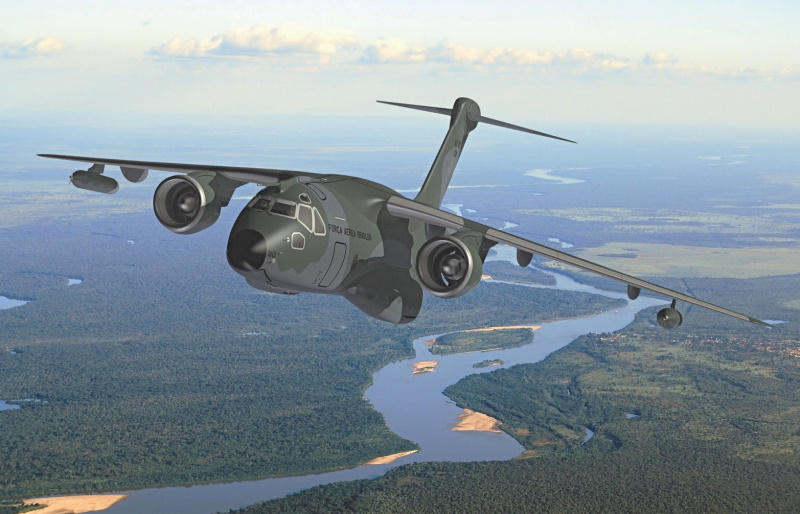
The design evolved into an effectively all-new aircraft with a maximum payload of 23 tonnes (25.3 tons), comfortably exceeding the 21.8 tonnes (24 tons) of the state-of-the-art C-130J. As introduced, the C-390 had a typical jet cargolifter configuration, with high swept wings, a high-bypass turbofan engine under each wing, a boxy fuselage with landing gear in sponsons, and a high tee tail with a tail loading ramp.
The aircraft was powered by International Aero Engines (IAE) V2500-E5 turbofans, with thrust in the range of 100 kN (10,200 kgp / 22,500 lbf); IAE is a consortium of Pratt & Whitney of the USA, Rolls-Royce of the UK, MTU of Germany, and Japan Aero Engine Corporation, with the V2500 series powering the Airbus A320 midsize jetliner family. The V2500-E5 engine was ruggedized, with a modified control system and an improved thrust reverser for short-field landing capability.
The cockpit featured a Rockwell-Collins Pro Line Fusion system, with five large-screen displays and twin HUDs. The cockpit was compatible with night vision goggles, and the aircraft was fitted with a defensive countermeasures suite. The C-390 incorporated a fly-by-wire flight control system implemented by BAE Systems of the UK.
The C-390's cargo compartment was 17.75 meters (58 feet 2 inches) long, 3.45 meters (11 feet 4 inches) wide, 2.9 meters (9 feet 6 inches) high forward of the wing, and 3.2 meters (10 feet 6 inches) high aft of the wing. Maximum payload of the C-390 was 26 tonnes (28.6 tons). One unusual feature was a movable pressure bulkhead that retracted garage door-style into the roof, and descended to seal the cargo cabin. When lowered, this sloping bulkhead reduced compartment length to 12.78 meters (41 feet 11 inches) at the ceiling. The KC-90 could carry up to 88 equipped troops, 66 paratroops, or 74 litters with attendants. Alternatively, it could carry up to seven standard cargo pallets, three tactical vehicles, a single LAV-25 combat vehicle, or a Sikorsky UH-60 Black Hawk helicopter.
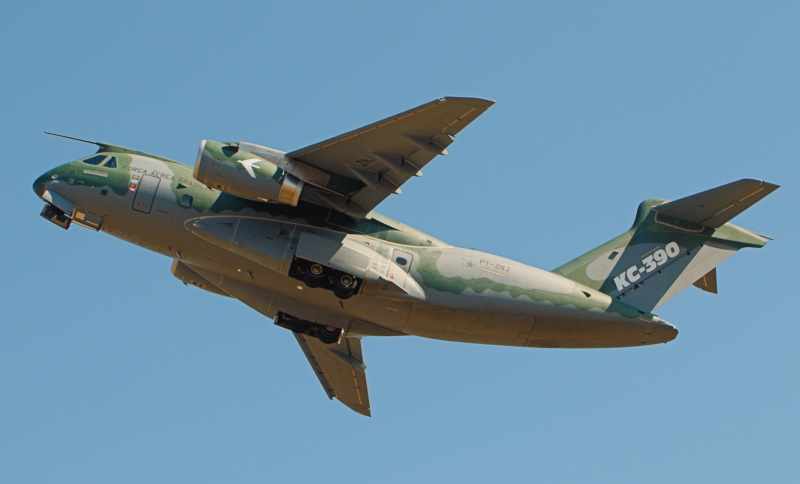
Baseline configuration featured an inflight refueling probe above the cockpit -- and for the tanker mission, a hose-drogue refueling pod under each wingtip. The refueling pods were supplied by Cobham Mission Equipment of the UK, being slightly altered from a standard Cobham product. Some potential customers have asked for a boom refueling unit; Embraer has considered the matter. In response to customer requests, the wingspan was extended during the design phase to 35.06 meters (115 feet) to support midair refueling of helicopters, requiring the ability to refuel at speeds down to 220 KPH (140 MPH / 120 KT), and altitudes below 3,050 meters (10,000 feet).
___________________________________________________________________
EMBRAER C-390:
___________________________________________________________________
wingspan:
35.06 meters (115 feet)
length:
33.91 meters (111 feet 4 inches)
height:
10.26 meters (33 feet 8 inches)
loaded weight:
74,000 kilograms (163,140 pounds)
max takeoff weight:
81,000 kilograms (178,575 pounds)
max speed:
988 kph (614 mph / 533 kt)
cruise speed:
870 kph (540 mph / 470 kt)
cruise altitude:
10,975 meters (36,000 feet)
range (half load):
4,815 kilometers (2,990 MI / 2,600 NMI)
range (full load):
2,590 kilometers (1,610 MI / 1,400 NMI)
___________________________________________________________________
In 2011 Embraer announced work on a stretched commercial derivative, with fuselage plugs fore and aft of the wing as well as a side cargo door. Nothing definite has been said about special mission derivatives of the C-390 -- such as maritime patrol, surveillance, search & rescue, AEW, or SIGINT platforms -- but they are options over the long run.
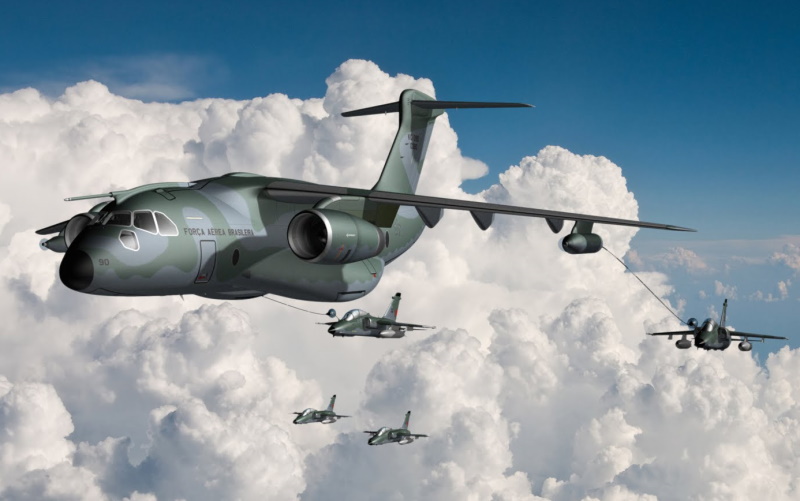
The first of two C-390 prototypes was rolled out in October 2014, with initial flight on 3 February 2015. The second prototype performed its first flight on 28 April 2016, with the first production machine performing its initial flight on 9 October 2018. The first delivery to the FAB was in 2019, with 28 to be obtained -- including the two prototypes, to be brought up to operational spec. In that same year, the designation was changed from KC-390 to C-390, the aircraft being given the name of "Millennium"; users flying it as a tanker will retain the KC-390 designation.
Portugal, which is a partner in the C-390 program, committed to buying five in 2017, with deliveries in 2023:2027. Other nations acquiring the aircraft include:
Other nations are interested in the Millennium, and further orders are likely.
BACK_TO_TOP* Illustrations details:
* This document has indirect origins. The materials on the A400M were originally partnered in a document on the Boeing C-17. The materials on the C-390 were originally released as part of a document on Embraer jetliners in 2013. I split them out in 2019, and consolidated them here.
Revision history:
v1.0.0 / 01 nov 19 / Assembled from existing materials. v1.0.1 / 01 sep 21 / Review & polish. v1.0.2 / 01 aug 23 / Review & polish. v1.1.0 / 01 aug 25 / Review, update, & polish. (!)BACK_TO_TOP
